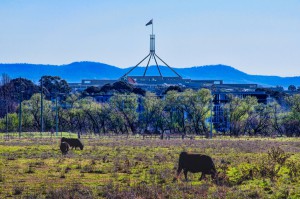Parliament House in Canberra might appear to be one of the biggest buildings in Australia, but the nation’s politicians, their minders and a small army of support staff ranging from cleaners to security personnel will soon be out of room and could need to annex nearby buildings.
Documents recently released to the market by the Department of Parliamentary Services reveal that the agency is now seeking advice on timelines and costings around when the giant edifice will be too small for requirements and need to send some functions away.
When completed in 1988, it seemed that Australia’s most physical representation of participatory democracy – which covers 32 hectares – would be easily sufficient to accommodate those working in and around federal government for the foreseeable future.
But population growth within the machinery of politics and government could soon require an accommodation upsize, and going up isn’t an option.
In documents provided to the market Parliamentary Services has called for a ‘Precinct Masterplan’ and an ‘Accommodation Masterplan’ “that sets out the ‘how, when, why, and at what cost’” for changes needed to keep things running in the year 2040.
More specifically it wants to know about “the provision of additional accommodation” and what “activities or functions that have or will be accommodated off-site.”
Nearby buildings appear to be firmly on the potential shopping list, perhaps providing a clue as to why a push to sell-off Parliamentary Circle property holdings following the Commission of Audit – like the Treasury Building – were nipped in the bud.
One line in the call for a new Masterplan asks for the “consideration of asset options within proximity to APH, through Commonwealth property portfolio, Commonwealth lease options, and private sector leasing.”
The big squeeze and eventual eviction for some will come is also a matter of ‘when’ rather than ‘if’, as the call for an ‘Accommodation Masterplan’ DPS bluntly spells out.
“Timelines for key events such as when might APH run out of space for various functions and departments once all options to improve the utilisation of the existing built asset are exhausted,” the documents say.
The document also canvasses the provision of recommendations “on an improved work place environment for all occupants” that include the Ministerial Wing and Executive Government, House of Representatives and Senate members’ suites, committees, the Parliamentary Library, media and DPS’ own “requirements for accommodation and future service demands noting the current disparate layout and quality of work space.”
While space for staffers and the press gallery has always been at a premium as their numbers increase, it’s DPS’ own staff whom appear to be doing it the toughest in terms of being given the worst offices – if you could call them that at all.
Indeed the very department whose job it is to run Parliament House seems to want out, thanks to their windowless subterranean digs.
“DPS would prefer accommodation that allows all its Divisions to be co-located. Over 100 DPS administrative and technical staff are located in basement office accommodation,” the documents state.
Contributing to the population pressure is a growing number of political staffers as well as an increase in the number of Parliamentary Secretaries who also need a better cut of office than your average Member of Senator.
There’s also the problem of making sure people, whether workers, visitors or tourists, can get in and out of Parliament House without languishing in long queues at the front door before passing through security.
According to DPS a routine day has around 3000 workers and visitors coming into the building which can balloon to 10,000 on busy sitting days, with “main entrance queuing and capacity improvements” specifically cited as an area of attention.
Comment below to have your say on this story.
If you have a news story or tip-off, get in touch at editorial@governmentnews.com.au.
Sign up to the Government News newsletter

